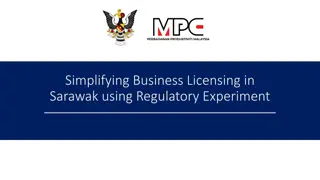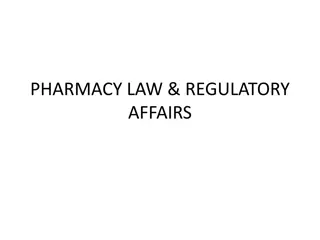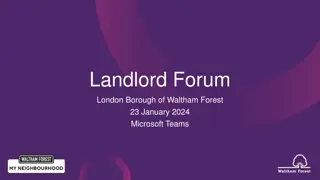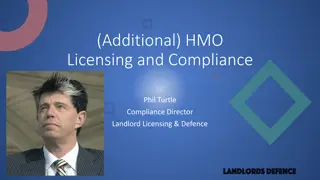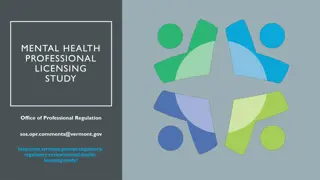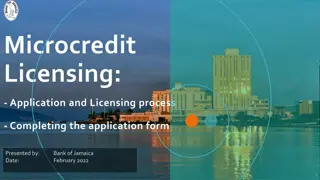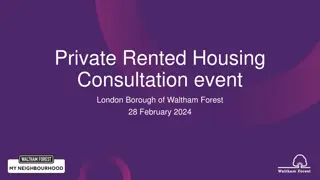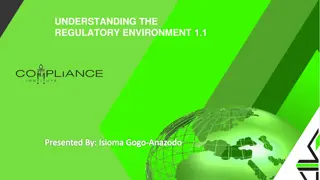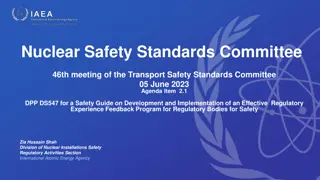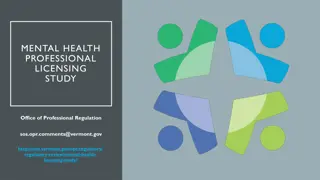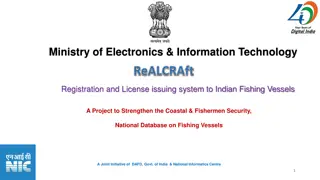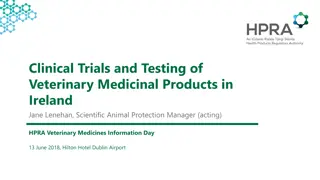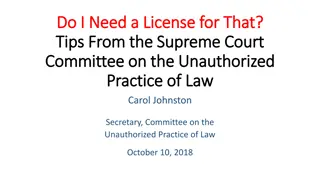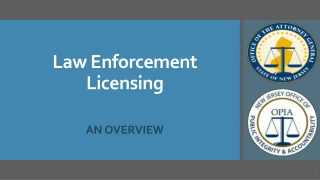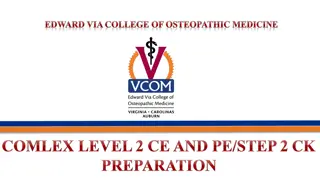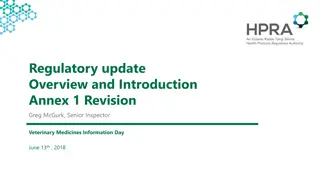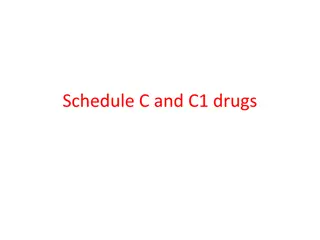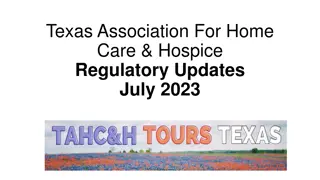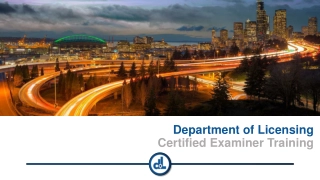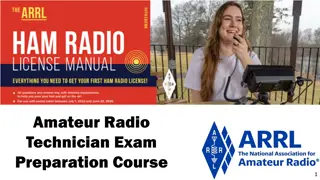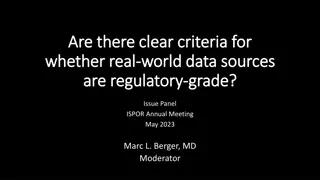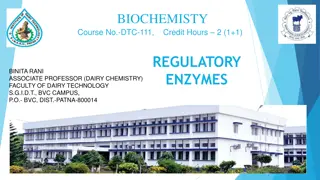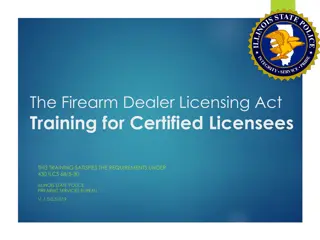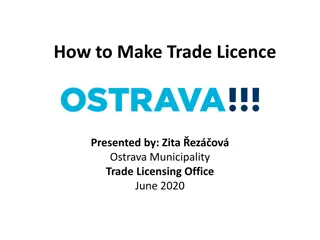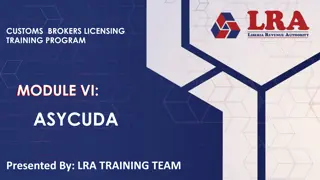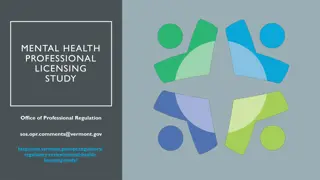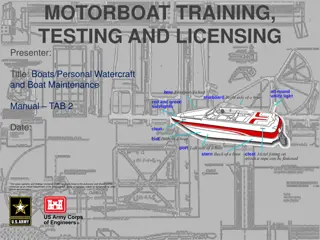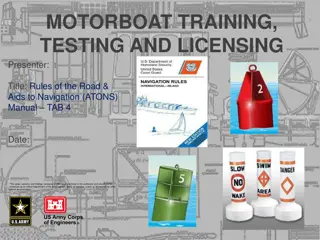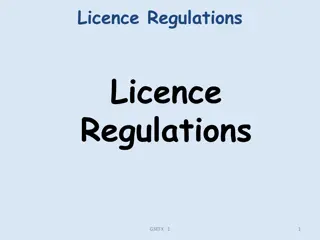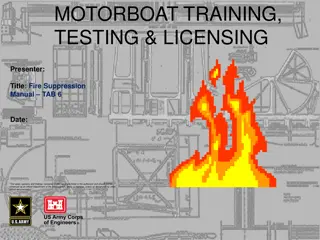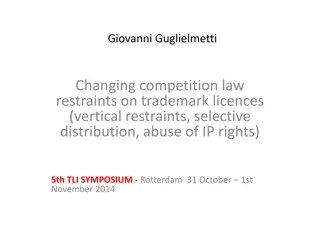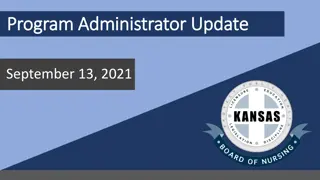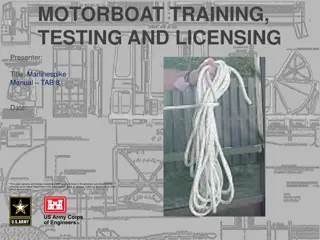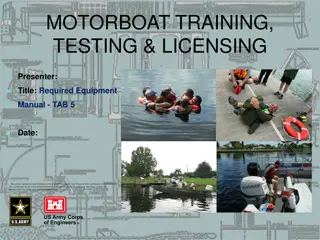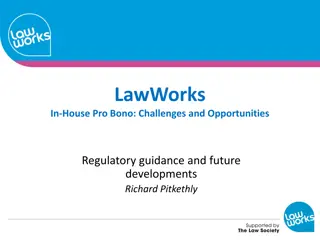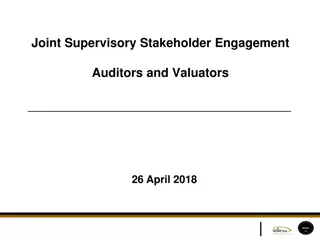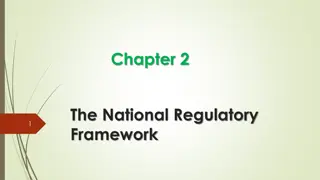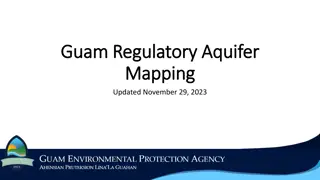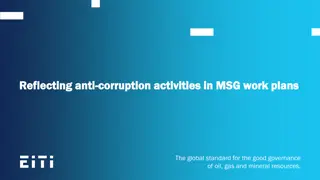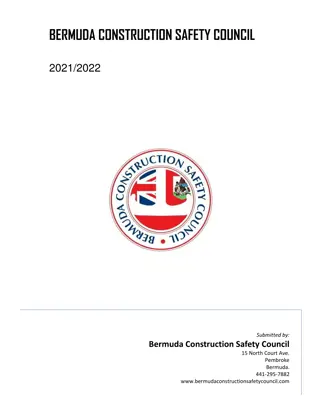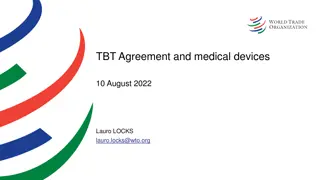Overview of NERSA's Licensing Process and Regulatory Activities
This presentation outlines NERSA's role, mandate, and regulatory activities in overseeing the electricity, piped-gas, and petroleum pipelines industries in South Africa. It covers the licensing process, types of licenses, application analysis, conditions, challenges, and corrective measures. NERSA's focus is on sustainable development, affordability, and accessibility while balancing economic interests for the benefit of all stakeholders.
Download Presentation

Please find below an Image/Link to download the presentation.
The content on the website is provided AS IS for your information and personal use only. It may not be sold, licensed, or shared on other websites without obtaining consent from the author. Download presentation by click this link. If you encounter any issues during the download, it is possible that the publisher has removed the file from their server.
E N D
Presentation Transcript
1 NERSA Presentation on Licensing Process Parliamentary Portfolio Committee 17 August 2021
PROPOSED PRESENTATION OUTLINE 1. Introduction 2. Types of Licenses 3. Process of Analysing applications 4. Number of licenses issued/Declined/Withdrawn/Cancelled 5. Documents to be submitted in support of applications 6. Applicable License Conditions 7. Main Challenges and corrective steps being taken 8. Conclusion 2
INTRODUCTION: LegislativeContext The National Energy Regulator (NERSA) is a Schedule 3A Public Entity as per the Public Finance Management Act, 1999 (Act No. 1 of 1999). NERSA was established on 1 October 2005 in terms of the National Energy Regulator Act, 2004 (Act No. 40 of 2004) to regulate the: o Electricity industry - in terms for the Electricity Regulation Act, 2006 (Act No. 4 of 2006); o Piped-Gas industry in terms of the Gas Act, 2001 (Act No. 48 of 2001); and o Petroleum Pipelines industry in terms of the Petroleum Pipelines Act, 2003 (Act No. 60 of 2003) 3 Levies Acts: o Gas Regulator Levies Act, 2002 (Act No. 75 of 2002); o Petroleum Pipelines Levies Act, 2004 (Act No. 28 of 2004); and o Section 5B of the Electricity Act, 1987 (Act No. 41 of 1987). 3
INTRODUCTION: Role NERSA s overarching role is to: ensure the development and sustainability of the electricity, piped-gas and petroleum pipelines industries; o while facilitating the affordability of and accessibility to the three regulated industries to balance the economic interests of all stakeholders This will ultimately support the government s objective of having a sustainable socio-economic development of South Africa and a better life for all. 4
INTRODUCTION: Mandate NERSA s Mandate is anchored in: 4 Primary Acts: o National Energy Regulator Act, 2004 (Act No. 40 of 2004); o Electricity Regulation Act, 2006 (Act No. 4 of 2006); o Gas Act, 2001 (Act No. 48 of 2001); and o Petroleum Pipelines Act, 2003 (Act No. 60 of 2003). 3 Levies Acts: o Gas Regulator Levies Act, 2002 (Act No. 75 of 2002); o Petroleum Pipelines Levies Act, 2004 (Act No. 28 of 2004); and o Section 5B of the Electricity Act, 1987 (Act No. 41 of 1987). 5
INTRODUCTION: Regulatory Activities NERSA s regulatory activities are grouped in the following programmes: Programme 1: Setting and/or approval of tariffs and prices Programme 2: Licensing and registration Programme 3: Compliance monitoring and enforcement Programme 4: Dispute resolution, including mediation, arbitration and handling of complaints Programme 5: Setting of rules, guidelines and codes for the regulation of the three energy industries Programme 6: Establishing NERSA as an efficient and effective regulator 6
Current Petroleum Pipelines Industry Value Chain WHO REGULATES WHAT? Downstream Upstream Marine loading Infrastructure : Refining (incl. primary storage) Exploration & Production Pipelines (Transmission) Wholesaling (incl. imports) Retailing Storage (Import & distribution) SA Petroleum Agency DMRE DMRE NERSA 8
Types of Licences Types of licences Construction (F1); Operation (F3); or Conversion (F2) Can be amended (facility details/extension of timelines) Type of facilities Pipeline (p); Loading (lf); Storage (sf); or Combined ( system consisting of p/lf/sf) 9
Process of Analysing applications Pre-licensing stage Adequacy 30 working days Confidentiality 30 working days Notice period 30 working days Response to objections (if any) 30 working days Finalisation of application (statutory timeframe as per the PPA) 60 working days Total 120 to 210 working days (180 day as per Act and the rules timeframe) The days provided above can be shortened based on the responsiveness of applicants 10
Number of licenses Issued Operation Licences (as at 31 March 2021) Qty Construction licences Analysis (as at 31 March 2021) In progress Province Storage facilities Pipeline Facilities Loading facilities Total 6 8 Pre-construction/on hold Western Cape 31 Kwa Zulu Natal 29 Eastern Cape 16 Northern Cape 7 Gauteng Free State Mpumalanga North West Limpopo Total 8 6 1 0 2 0 1 0 0 18 9 8 8 0 0 0 0 0 0 25 48 43 25 7 31 23 18 15 13 223 40 Completed 3 Revoked (completed & change of ownership) 29 23 17 15 13 180 5 Revoked (project terminated) 62 Total issued Conversion Licence: There has been no application for conversion licence lodged or processed. 11
Transformation (BEE) & Investment Investment by licensees: CONSTRUCTION LICENCES ISSUED: 1 JANUARY 2018 TO 31 JULY 2021 = 6 projects;R4.753 bN CONTRUCTION PROJECTS COMPLETED - 1 JANUARY 2018 TO 31 JULY 2021 = 7 projects; R5.64 bN 12
Documents to be submitted in support of applications Section 16 (1) of PPA Any person who has to apply for a licence must be the owner of the pipeline or facility in question. Petroleum Pipeline Rules outlines the form and procedure to be followed in applying for a license including ddocuments pertaining to: Company details (ownership/BEE credentials) Agreements (sale/session/terminal operation) Facility details (GPS Coordinates, site layout/flow diagrams) Codes, Standard, specifications and Operational Procedures Environmental/other regulatory approvals/permits The operation license must be submitted together with a tariff application. Applicant may request confidential treatment of information contained in an application. 1. 2. 3. 4. 13
Applicable License Conditions CHAPTER 1: LICENSED ACTIVITY 1. Licensed Activity 2. Commencement and Duration of License CHAPTER TWO: GENERAL CONDITIONS 3. General Conditions of Licence 4. Compliance with Conditions of Licence 5. Compliance with Legislation, Operation Codes and Standards 6. Amendment of Licence 7. Revocation of Licence 8. Changes in Details of the Licensee 9. Changes to the Facilities 10. Correspondence with NERSA CHAPTER 3: SPECIFIC CONDITIONS 11. Commencement and Completion of Construction 12. Information for monitoring Purposes 13. Regulatory Reporting 14. Entry, Inspection and Gathering of Information 15. Provision of Information to the Energy Regulator 16. Ancillary Obligations 17. Whole Licence 14
Main Challenges and corrective steps being taken Challenges Capital intensive nature of projects Interventions needed Funding to be made available/ institutions Securing product supply/Signing of take-off agreements Determine uncommitted capacity on a forward looking basis Joint ventures/strategic partners Structural issues to be addressed (remove barriers / level playing field) Alignment of processes & coordination (integrated process)15 Proving financial abilities (new entrants) for bankability Third party access (import facilities and pipeline) Transformation Limited competition Regulatory burden/Overlapping mandates (approvals needed)
SUPPORT REQUESTED IN RESPECT OF IDENTIFIED REGULATORY CHALLENGES ARE THE FOLLOWING Amendments to the PPA and Regulations: Definitions in the PPA Registration (similar to Gas and Electricity) More powers to enforce compliance Addressing fragmented regulation Overlapping/concurrent mandates Alignment of processes/coordination between Government Depts/ Authorities/Agencies Funding support for new entrants 15
TRADITIONAL NATURAL GAS VALUE CHAIN The gas value chain comprises of the elements below 3D seismic study - Gas extraction Geophysical evaluation - Field development & design - Continuing drilling Drilling operations operations Transportation, Liquefaction, regasification & Storage Processing End users Production Exploration - Gathering & - Transportation processing (Pipeline/LNG shipping) - Power generation - Fractionation - Liquefaction - LNG regasification/storage - Residential - CNG/LNG distribution - Transportation (Tetra4)(Novo, VGN, SL CNG)(e.g. SAB, Arcelor Mittal) - Industrial - Commercial (Tetra4 Petro SA, (Total, Shell, SPI) Sasol Production Int.) UPSTREAM NERSA registers production, importation & own use MIDSTREAM DOWNSTREAM NERSA s JURISDICTION (Excl. gas reticulation) 18
Types of Licenses Activities required to be licensed in terms section 15 of the Gas Act, 2001 (Act No. 48 of 2001): construction of gas transmission, storage, distribution, liquefaction and re-gasification facilities; conversion of infrastructure into transmission, storage, distribution, liquefaction and re-gasification facilities; operation of gas transmission, storage, distribution, liquefaction, and re-gasification facilities; and trading in gas; 19
Process of Analysing applications Application is received and captured on LMS System A Receipt and reference number is issued to Applicant Confidentiality request application assessed and considered 30 days An applicant must advertise the application in at least two newspapers circulating in the area of the proposed activity/facility to be licensed in English and any other language 30 days A notice for the public hearing (PH) is issued by NERSA at least 7 days before date of the PH In terms of the Gas Act, a decision must be taken within 60 days after close of period for comments or in the event of an objection, after date of the applicant s response to the objections. Process may take 90 days if no objection is received and 120 days if an objection is received 20
Documents to be submitted in support of applications Physical location (proof of tenure); Detailed description of the proposed facility; Detailed engineering design; Design specifications including capacity; Detailed process description; Proof of financial viability of the facility including; Projected cash flows, DCF model with assumptions used; Proof of funding from financial backers or banks, equity funding etc. Tariffs to be charged for the facility and details of methodology for calculation; 21
Documents to be submitted in support of applications Customer details (current and potential); Details of gas /LNG source (firm commitments); Details of the proposed TPA allocation mechanism (storage and transmission facilities); TPA currently not applicable to the Re-gasification facility. However, Gas Amendment Bill makes provisions for such; Details about any contracts already entered into (e.g., Gas Transportation Agreements, Storage Agreements, Gas Supply Agreements); Details of future capacity expansion plans for the proposed facility; Period within which the facility to be operational must be stated. Applicant s financial, technical and administrative ability to conduct the licensed activities 22
Documents to be submitted in support of applications A certified copy of the Record of Decision of the relevant environmental authorities in accordance with the National Environmental Management Act, 1998 (Act No. 107 of 1998) permitting the activity for which the licence is sought, if applicable. OR proof that an application has been made for the permit. A List all applicable legislation; operating and technical standards; and codes and specifications (including those relating to safety) to be used in the activities for which this application is made. Detailed technical specifications of the gas that will be handled at the facility for which this application is made, 23
Number of licenses Issued/Declined/Withdrawn/Cancelled Inactivity To date: Licenses issued 254 Licenses withdrawn 3 Licenses revoked 7 (revoked by licensees who no longer require the licenses e.g. construction licenses revoked after construction activities were completed) Licenses not granted - 2 24
Applicable License Conditions The Gas Regulator may impose licence conditions within the following framework of requirements and limitations: A licensee must carry out the construction, operation or trading activities for which the licence is granted; licensees must provide information to the Gas Regulator of the commercial arrangements regarding the participation of historically disadvantaged South Africans in the licensees' activities as prescribed by regulation and other relevant legislation; the gas transmission, storage, distribution, trading, liquefaction and re-gasification activities of vertically integrated companies must be managed separately with separate accounts and data and with no cross-subsidization; 25
Applicable License Conditions third parties must in the prescribed manner have access on commercially reasonable terms to uncommitted capacity in transmission pipelines; interested parties must be allowed to negotiate changes with transmission companies in the routing, size and capacity of proposed pipelines; interested parties must be allowed to negotiate with transmission companies for increases in compression of existing transmission pipelines and all pipeline customers must benefit equitably from reduced costs resulting from the increased volume; the total cost for the pipeline must be shared equitably between the transmission company and the parties requesting the change; licensees must allow interconnections with the facilities of suppliers of gas, transmitters, storage companies, distributors, reticulators and eligible customers, as long as the interconnection is technically feasible and the person requesting the interconnection bears the increased costs occasioned thereby, which must be taken into account when setting their tariffs; third parties must in the prescribed manner have access on commercially reasonable terms to uncommitted capacity in storage facilities: 26
Applicable License Conditions interested parties may negotiate with storage companies for changes in the capacity of storage facilities; the total cost for the storage facility must be shared equitably between the storage company and the party requesting the change; apart from direct sales via physical by-passes to eligible customers who may alternatively have access to the distribution network at the distributor's discretion, a distributor will be granted an exclusive geographic area, but only for a particular range of specifications of gas determined by the Gas Regulator; a distributor will be granted the construction, operation and trading licences for its exclusive geographic area. The construction and operation licences will be exclusive for the period of validity of such licences, and the trading licence 25 will be exclusive for a period determined by the Gas Regulator; an exclusive geographic area must be based on the distributor's ability to supply present and future potential consumers at competitive prices and conditions; 27
Applicable License Conditions maximum prices for distributors, reticulators all classes of consumers must be approved by the Gas Regulator where there is inadequate competition as contemplated in Chapters 2 and 3 of the Competition Act, 1998 (Act No. 89 of 1998); an advisory service with regard to the safe and efficient use, handling and storage of gas must be provided to customers other than eligible customers, by the trading licensee; licensees must maintain their facilities in a fully operative condition; all customers in a licensed distribution area, except eligible customers and reticulators, must purchase their gas from the distribution company licensed for that area; the time period within which gas facilities will become operational must be fixed; and licensees must provide information necessary for the Gas Regulator to perform its functions. 28
NERSA assist applicants to comply with the licensing requirements through (1) Pre-licence application meetings Done ito section 15(4)(a) of the Gas Act to allow applicants to discuss their proposed activities and for NERSA to explain the licensing requirements and the process before the licence application is filed. (2) Written requests for additional information To close the gaps in the licence applications. To seek clarity or verify information already submitted in the application. (3) Continued engagements between the applicant and licensing department To provide step-by-step guidance on the licensing process. (4) Stakeholder workshops Stakeholder workshops on the legislative/regulatory framework conducted on an annual basis, and as and when needed on specific regulatory matters. 29
Main Challenges and corrective steps/proposed solution Challenge Proposed Solution Expedite finalization of Gas Amendment Bill 1. Lack of adequate provisions in the current Gas Act e.g. definition of gas, no provisions for TPA to distribution facilities Pre-licensing meetings with prospective applicants to clarity application requirements before submission of licence applications 2. Incomplete information in licence applications NERSA and TNPA already working to coordinate their processes. However, a more streamlined process for strategic gas projects is needed 3. Lack of proof of tenure (lease agreement) with the Ports Authority. No proof that applicants obtained approval from TNPA for siting LNG import facilities in the ports. Some applicants could not demonstrate that they have at least initiated the TNPA processes 4. Lack of co-ordinated approach to infrastructure development - Hampers orderly development of the gas market Finalize development of the Gas Master Plan which maps the medium to long-term gas supply and demand profile for the country. This would assist potential project developers to identify the demand nodes and to determine the infrastructure capacity needs 30
Types of Licenses Generation licences Eskom licence (Coal, Solar, Hydro, Pumped Storage, Nuclear, OCGT) IPP as result of DMRE Procurement Process (Renewable Energy, Coal, Gas, Hybrid, Battery Storage) IPP Not from DMRE Procurement Process IRP Deviations approved by the Minister (Cogeneration, Bi-laterals, Gas-Not from REIPP) Distribution licences (Eskom, Municipalities, Private) Trading licence (PowerX) Transmission licences (Eskom, Motraco) 32
Process of Analysing licence applications NERSA receives application Checks for information adequacy If information is adequate, NERSA informs the applicant and start processing the application (it happens sometimes that NERSA only realize the inadequacy of information when it starts processing the application, e.g. that the PPA has defective clauses) Applicant is advised to advertise the application in local newspapers NERSA analyze the objections/complements in the Aide Memoir NERSA advertise and hold a public hearing 33
Process of Analysing licence applications (Cont.) Information gathered from public hearings is incorporated in the Aide Memoir The Submission is tabled before the Electricity Subcommittee where it will be considered and recommended to the Energy Regulator The submission is considered by the Energy Regulator where a final decision is taken The applicant is informed of the Energy Regulator s decision. 34
Process of Analysing Registration applications NERSA receives application Checks for information adequacy If information is adequate, NERSA informs the applicant and start processing the application (it happens sometimes that NERSA only realize the inadequacy of information when it starts processing the application, e.g. that the PPA has defective clauses) The Submission is tabled before the Electricity Subcommittee where it will be considered and approved 35
Number of licenses Issued Number of generation licences: Eskom 32 power stations Municipalities 12 IPP including Renewable Energy - 155 NERSA has registered 375 generation facilities of no more than 1MW with a total capacity of 165MW 36
Number of licenses Issued/ Declined/Withdrawn/Cancelled Total Distribution licensees = 178 including Eskom: 165 Municipalities 12 Private Distributors 1 Eskom Two Transmission licences Eskom Motraco One Trading licence There were no licences declined / withdrawn / cancelled 37
Documents to be submitted in support of applications GENERATION LICENCE APPLICATIONS Power Purchase Agreements (PPAs) Project technical information including feasibility studies and energy resource availability for renewable energies Fuel Supply Agreement if applicable Environmental Impact Assessment Record of Decision from the Department of Water and Environmental Affairs Electronic Financial model on a CD or memory stick in excel format or such other format that can be interrogated to test the different scenarios (e.g. what would be the tariff for different load factors). Explanatory notes in word must also be attached to explain financial indicators like IRR after tax. Economic information including socio-economic commitments Human Resources including compliance with BBBEE Wheeling agreements where applicable Ministerial approval for deviation from the IRP if the project is not in the applicable IRP Legal or Regulatory compliance 38
Applicable License Conditions The right to operate generation, transmission or distribution facilities, to import or export electricity, to trade or to perform prescribed activities relating thereto, including exclusive rights to do so, and conditions attached to or limiting such rights; The duty or obligation to trade, or to generate, transmit or distribute, electricity, and conditions attached to such duties or obligations; Compliance with directives to govern relations between a licensee and its or end users, including the establishment of or end user forums; Furnishing of information, documents and details that the Regulator may require for the purposes of the Electricity Regulation Act; The period of validity of the licence in accordance with section 20; The setting and approval of prices, charges, rates and tariffs charged by licensees; Compliance the contents of agreements entered into by licensees; The regulation of the revenues of licensees; The setting, approving and meeting of performance improvement targets, including the monitoring thereof through certificates of performance; The quality of electricity supply and service; The cession, transfer or encumbrance of licences, including the compulsory transfer of a licence to another person under certain conditions, and terms and conditions relating thereto; 39
Applicable License Conditions (Cont.) The termination of electricity supply to customers and end users under certain circumstances, the duty to reconnect without undue discrimination, and conditions relating thereto; The area of electricity supply to which a licensee is entitled or bound; The classes of customers and end users to whom electricity may or must be supplied; The persons from whom and to whom electricity must or may be bought or sold; The types of energy sources from which electricity must or may be generated, bought or sold; Compliance with health, safety and environmental standards and requirements; Compliance with any regulation, rule or code made under this Act; Compliance with energy efficiency standards and requirements, including demand- side management; The undertaking of customer or end user education programmes; The need to maintain facilities in a fully operational condition; The period within which licensed facilities must become operational; and any other condition prescribed by the Regulator. 40
Main Challenges and corrective steps being taken Applicants do not want to spent any money on project development without getting a licence first. Applications would then be submitted without Environmental Authorisations, technical and financial feasibility studies. NERSA has already relaxed the requirement for complete EA but it still requires technical and financial feasibility studies, because these requirements are legislated as well as evidence that EA process was initiated. Applicants do not want to undergo public participation process but it s a legal requirement for NERSA. Without the public participation process, NERSA s decision can be easily challenged in court. NERSA is holding conferences to educate the public. The requirements for connection consent letters differs greatly amongst the NSP. To address this, NERSA is designing Regulatory Rules on Third party Transportation of Energy. Non-compliance to licence conditions by Municipalities. To address this, NERSA has intensified Audits 41
CONCLUSION NERSA would like to thank the members of the Portfolio Committee for the opportunity to brief them on the licensing regime; The results of NERSA s work continue to have a profound impact on the lives of ordinary people as well as on the economy of the country; The regulation of the three energy industries characteristically continues to pose challenges in that the Energy Regulator is required to balance the conflicting interests of licensees, investors, consumers/end-users and the policy maker; To deal with regulatory challenges, NERSA has undertaken various initiatives to refine licensing systems, regulatory practices and methodologies in its quest to become a world-class leader in energy regulation and will continue to do so. 42
Thank you Website: www.nersa.org.za Tel: 012 401 4600 Fax: 012 401 4700 Email: info@nersa.org.za @NERSAZA @NERSA_ZA 43


